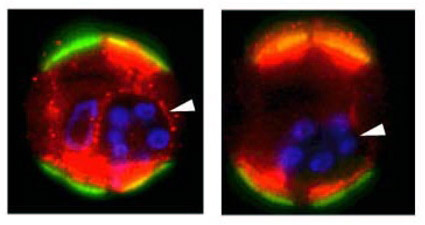| RIKEN Center for Developmental Biology
(CDB) 2-2-3 Minatojima minamimachi, Chuo-ku, Kobe 650-0047, Japan |
December 22, 2003 – In every stage of development, cells are directed to make their way through the body to contribute to the building of or take up residence in new tissues and organs. The guidance of cell migration is achieved by signals intrinsic to the cell or from its surrounding environment. In work published on December 21 in the online edition of Nature Cell Biology, the RIKEN Center for Developmental Biology (CDB) Laboratory for Cell Migration, under team leader Kiyoji Nishiwaki, has demonstrated the role of a protein modification known as glycosylation in guiding the migration of gonadal cells in the nematode, C. elegans. This study, conducted in collaboration with researchers from the Japanese National Institute
of Advanced Industrial Science and Technology, and the Universities of Nagoya (Japan) and
Toronto (Canada), is the first to reveal the function of glycosylation in the action of
an ADAM-family protease, a finding of potential significance to the study and treatment
of human autoimmune diseases and other disorders that involve defects in ADAM-family protein
function. MIG-17 is an ADAM (a disintegrin and metalloprotease) protease, a family of secreted or membrane proteins first identified as components of various snake venoms, where they have hemorrhagic and anti-coagulatory effects. ADAM-family proteases have been implicated in a number of human physiological and pathological processes, including blood coagulation disorders, rheumatoid arthritis and asthma. These proteins act to proteolytically release membrane-bound growth factors or to disrupt components of extracellular matrices such as collagen and proteoglycans (which help to build skin and soft tissue), and their roles in development and differentiation are the focus of interest in many research labs.
Nishiwaki’s team analyzed a number of mutations that result in aberrant gonadal phenotypes similar to those seen in mig-17 mutants, including the mutation of the gene that encodes MIG-23. This protein was found to be structurally related to nucleoside diphosphatases (NDPases), glycosylating proteins found in the Golgi apparatus, the intracellular processing center where proteins are modified, sorted and released from the cell. Glycosylation involves the addition of a sugar to a site on a protein chain, a post-translational modification whose roles are incompletely understood, but which is thought to serve a regulatory function in some signaling molecules. On further investigation, MIG-23 mutants showed reductions in NDPase activity. The wild-type MIG-23 protein successfully rescued yeast mutants for NDPase, lending solid support to the case for the NDPase nature of MIG-23. The similarity between the MIG-23 and MIG-17 phenotypes suggested that the mutation of MIG-23 might result in abnormal MIG-17 glycosylation. Using gel electrophoresis, Nishiwaki and colleagues demonstrated that MIG-17 molecules in MIG-23 mutants had lower than normal molecular weights consistent with the loss of glycosylation, while immunoblotting studies confirmed that in these mutants MIG-17 failed to bind sugars at the normal levels. MIG-17 molecules designed with deficient glycosylation sites also failed to localize at the gonad and showed no ability to direct its migration. Genetic analyses revealed that MIG-23 is expressed in muscle cells, which reconciles well with MIG-17’s muscle cell origins. Taken together, these results indicate that MIG-17 molecules are secreted from muscle cells after glycosylation by MIG-23, a modification which enables their recruitment to the migrating gonad. Although Golgi NDPases such as MIG-23 can conceivably modify a number of other secreted proteins, the Nishiwaki study indicates that the effects of the NDPase dysfunction are especially prominent in the abnormal glycosylation and function of an ADAM family protease, suggesting that glycosylation may play a more important role in the function of proteins in this family than it does in that of other secreted proteins. ADAM family proteases are known to be involved in a number of human diseases, and the question of whether glycosylation defects play a role in their pathogenesis merits further investigation. Research such as this provides insights into basic biological mechanisms that may one day make it possible to treat a range of health conditions by restoring normal ADAM protease glycosylation in cases in which it is aberrant. |
|||||
|
|||||
[ Contact ] Douglas Sipp : sipp@cdb.riken.jp TEL : +81-78-306-3043 RIKEN CDB, Office for Science Communications and International Affairs |
| Copyright (C) CENTER FOR DEVELOPMENTAL BIOLOGY All rights reserved. |
